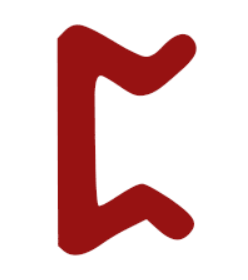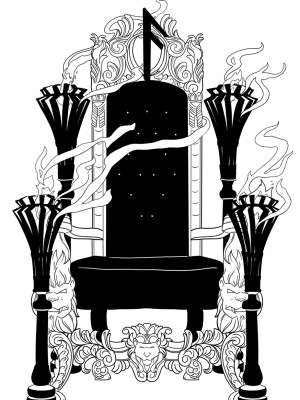Njord Costuming
Njordic clothing overlaps considerably between the feminine and masculine. Clothing pieces often incorporate intricate embroidery, beads and furs. Wool cloaks, jackets and furs are commonplace due to the harsh conditions in Njordr. Many clans have their own particular style of dress, varying their jewelry and accessories and incorporating particular colors into their clothing.
Feminine
Njord feminine dress typically consist of a strap dress with an undergarment or smock underneath. Dress Straps are fastened at the front with brooches. Brooch shape varies, but are most often circular or oblong. Brooches are sometimes made in the shape of animal heads including those of a bear, a wolf or a stag. Strings of beads are often hung between the two brooches. Bead material ranges from heavy colored glass, to metal or gemstones. Bead strands are sturdy, and it is not uncommon for women to hang small practical items from these strands as well (keys, needle cases, small combs etc.). Cloaks and dresses can be decorated with woven borders and bands of fur. Belts of woven cloth or leather are also common in feminine dressing, allowing the wearer to carry more essential items with them in pouches, or through individual belt attachment.
Masculine
Masculine dress oftens consists of a tunic, trousers and a cloak.
Tunics are a long-armed shirt without buttons that might go down to the knees. A keyhole neckline was the most common, although many other shapes are used for the neck opening. A wide range of styles of trousers are used- tight, baggy or of simple construction. When trousers are shorter than full length it’s not uncommon among masculine dressers to wear stockings .
Caps, either pointed or with rounded crowns are also common. Leg wrappings from knee to foot to gather the excess fabric of their baggy trousers can often be seen, as well.
Hair Styles
Masculine and Feminine hair styles are similar among Njords. Hair is typically long and worn free hanging or in intricate braids and or knots, often decorated with beads. Head scarves are sometimes worn by feminine individuals, knotted at the base of the neck to protect the hair from damage. NOTE: While these styles are traditional, players should not worry about adhering to suggested hairstyles; these are just recommendations to give you a starting point in your own costuming journey.
In addition to complex braids and decorative hairstyles Njordic culture favors decorative scalp tattoos (in the absence of hair), these tattoos are very elaborate often depicting knot work, runes, or other pictorial imagery. It is not uncommon for these tattoos to tell a story, from myth or from the individual’s life.
Clan Specific Costuming
While there are some clothing commonalities between Njords, individual clans have specific colors and accessories that distinguish them from one another.
Bearhide
Clan Bearhide is known for their black and brown furs taken from the backs of ferocious bears. They also incorporate their hides, teeth and bones into their clothing and armor. Some even wear gloves fashioned with bear claws. They make liberal use of wooden beads in both their hair and in their jewelry. Tattoos of bears and bear claws on the hands and face are very common, especially among the younger generation.
Blood Eagles
A Blood Eagle clan member can be easily identified by their preference for bright red clothing- they feel no need to hide when they are living a life of honor and bravery in service to white Benalus. Where they once adorned themselves with imagery of the Old Gods, they now proudly wear the images of their new faith. One of the most prominent examples of this can be seen in their facepaint. Blood Eagles are known to bisect their faces with the symbol of the templars- a large cross. Red in color this cross spans the entirety of the face, with a vertical line beginning at the hairline and extending to the jaw; placement of the horizontal line varies, but extends the width of the face.
Frost Raven
Trade is an integral part of the Frost Raven way of life, the fruits of which are present in their dress. This clan can be identified by their eclectic- almost disjointed way of dress. Frost Raven’s care less about a cohesive aesthetic, and more about demonstrating their trade relations. A variety of colors, fabrics and accessories adorn the Frost Ravens with only a single consistency- prominent white corvid imagery, which adorns clothes and jewelry alike. Like their ancient guide, members of this clan have a fondness for assorted bobbles and shiny objects, opting to display their treasures on their person.
Greywolf
Greywolf clans people clad themselves in the deep greens and grays of the lands they hunt. Furs are a staple in their dress, and wearing this skin of a wolf is considered to be a symbol of status within the clan. Wolf imagery is a common accessory, and armor is more commonly worn among this clan. Facepaint is varied among the Greywolves, but it is common for this clan to replicate the natural marking of the wolf as a way of honoring their powerful namesake.
Runespeaker
This clan of scholars favors deep yellows and golds in their dress, and make a point of adorning themselves with runes and symbols from their dwarven allies. It is traditional for members of this clan to carry a representation of their coming of age prophecy on their person, as a reminder of their higher purpose. Facepaint among this clan tends towards metallic hues, although their fondness for yellows and golds can be seen here as well.
Shadowhall
Dark rich colors are favored by members of this mountain dwelling clan. While many Shadow Hall clan members choose to wear black, deep reds, purples and dark blue are also seen in this group. Leather is common in the clothing of the Shadow Hall clan, though this choice is more a practical than aesthetic one. As blacksmiths, this durable material is a necessity. Weapons are prominently displayed for both practical and decorative purposes as these mountain smiths are proud of their craftsmanship. Facepaint among the Shadow Hall clan typically favors black and gray, as the paint is often made of the ash from their powerful forges.
Snow Lions
This nomadic group favors colors of the earth in their clothing; browns, greens, rusts. Furs are prominently featured in their dress- Elk and reindeer are most common, although powerful clan members may be adorned with the thick pale pelts of the great wild cats they are named for. As hunters and farmers, the tools that help them survive rarely leave their sides. It is not uncommon to see farming implements secured on a Snow Lion’s belt alongside their weapons. Facepaint among the Snow Lions aims to help them blend in with their surroundings making light colors and earth tones very common.
Stonehearth
Due to the controversy of their ancestry, keeping a low profile is of the utmost importance for members of the Stonehearth clan. Gray is favored by this clan, and they joke that all colors fade to gray on the sea. Facepaint is often gray and blue, and tends to be minimal rather than ostentatious. This shadowy clan boasts minimal accessories and prides themselves on a rather unremarkable appearance.
White Eyes
The White Eyes clan is known to dress in subdued colors, favoring gray, pale blue, and other natural hues. There is very little difference in how the men and women of this clan dress, even more than among the other Njord clans, varying in both directions without remark. In homage to their founder, this clan opts for white face paint often drawing focus towards their eyes. Before entering battle or other life threatening situations, members of this clan will mark themselves with the symbol of the Disir- the Perth rune. Using this symbol draws the eyes of their foremothers, to witness their great deeds and to ask for their guidance into the afterlife should they fall.

